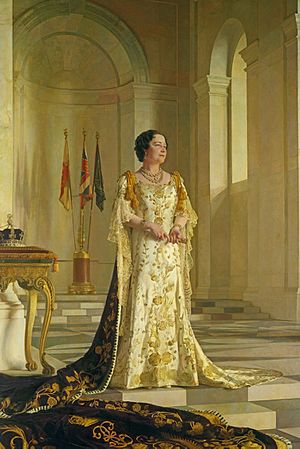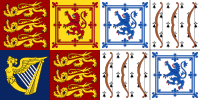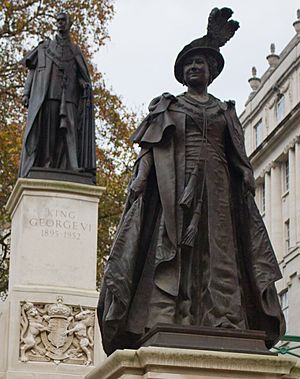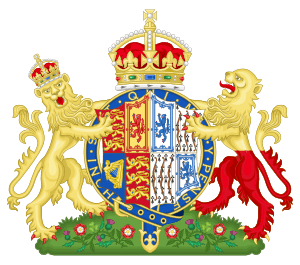Queen Elizabeth The Queen Mother facts for kids
Quick facts for kids Elizabeth Bowes-Lyon |
|
|---|---|
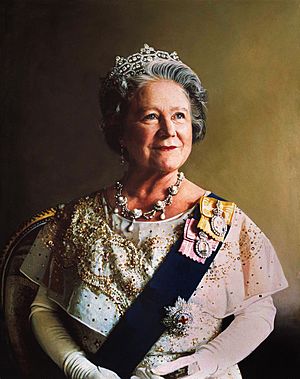
Portrait by Richard Stone, 1986
|
|
| Queen consort of the United Kingdom and the British Dominions |
|
| Tenure | 11 December 1936 – 6 February 1952 |
| Coronation | 12 May 1937 |
| Empress consort of India | |
| Tenure | 11 December 1936 – 15 August 1947 |
| Born | Elizabeth Angela Marguerite Bowes-Lyon 4 August 1900 Hitchin or London, United Kingdom |
| Died | 30 March 2002 (aged 101) Royal Lodge, Windsor, Berkshire, United Kingdom |
| Burial | 9 April 2002 King George VI Memorial Chapel, St George's Chapel, Windsor Castle |
| Spouse | |
| Issue | |
| House | Bowes-Lyon |
| Father | Claude Bowes-Lyon, 14th Earl of Strathmore and Kinghorne |
| Mother | Cecilia Cavendish-Bentinck |
| Signature |  |
Elizabeth Angela Marguerite Bowes-Lyon (born August 4, 1900 – died March 30, 2002) was the Queen of the United Kingdom. She was also Queen of the British Commonwealth from 1936 to 1952. She held these titles as the wife of King George VI. She was also the last Empress of India until 1947. After her husband passed away, she was known as Queen Elizabeth The Queen Mother. This helped avoid confusion with her daughter, Queen Elizabeth II.
Elizabeth was born into a noble British family. She became well-known in 1923 when she married Prince Albert. He was the second son of King George V. The couple and their daughters, Elizabeth and Margaret, were seen as a model family. The Duchess took part in many public events. She was known for her cheerful and positive attitude.
In 1936, Elizabeth's husband unexpectedly became king. His older brother, Edward VIII, gave up the throne. He wanted to marry an American woman named Wallis Simpson. Elizabeth then became queen. She traveled with her husband to France and North America. This was before World War II began. During the war, her strong spirit gave hope to the British people. After the war, her husband's health got worse. She became a widow at 51. Her older daughter, Elizabeth, became the new queen at 25.
After Queen Mary died in 1953, Elizabeth was seen as the leader of the royal family. In her later years, she remained very popular. This was true even when other family members faced criticism. She continued her public duties until just before her death. She passed away at 101 years old. This was seven weeks after her younger daughter, Princess Margaret, died.
Contents
Growing Up
Elizabeth Angela Marguerite Bowes-Lyon was the youngest daughter in her family. She was the ninth of ten children. Her parents were Claude Bowes-Lyon and Cecilia Cavendish-Bentinck. Her mother's family included a British Prime Minister.
It's not fully known where Elizabeth was born. Some say it was at her parents' home in London. Others believe it was in a horse-drawn ambulance. Her birth was officially recorded in Hitchin, Hertfordshire. This was near her family's country home. She was baptized there in September 1900.

She spent most of her childhood at St Paul's Walden and Glamis Castle. Glamis Castle was her family's old home in Scotland. She was taught at home by a governess until she was eight. She loved outdoor sports, ponies, and dogs. When she started school in London, she surprised her teachers. She began an essay with two Greek words. Her favorite subjects were literature and scripture. Later, she was taught by a German Jewish governess. She passed an important exam with high marks at age thirteen.
On her fourteenth birthday, Britain declared war on Germany. This was the start of World War I. Four of her brothers joined the army. Her older brother, Fergus, was killed in 1915. Another brother, Michael, was reported missing in 1917. Three weeks later, they learned he was captured. He stayed in a prisoner of war camp for the rest of the war. Glamis Castle was turned into a hospital for wounded soldiers. Elizabeth helped to run it. She also helped save the castle's contents during a big fire in 1916.
Marrying Prince Albert
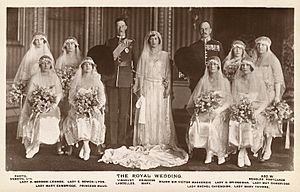
Prince Albert, Duke of York, known as "Bertie," was King George V's second son. He first asked Elizabeth to marry him in 1921. But she said no. She was afraid of losing her freedom. Albert said he would not marry anyone else. His mother, Queen Mary, then visited Elizabeth. She became sure Elizabeth was the right person for Albert.
In February 1922, Elizabeth was a bridesmaid. She was at the wedding of Albert's sister, Princess Mary. The next month, Albert proposed again, but she still said no. Finally, in January 1923, Elizabeth agreed to marry Albert. She still had some worries about royal life. Albert was free to choose Elizabeth, who was not a royal. This was seen as a modern step. Before, princes usually married princesses from other royal families.
They chose a platinum engagement ring. It had a beautiful sapphire and two diamonds. They married on April 26, 1923, at Westminster Abbey. Elizabeth did something unexpected. She placed her wedding bouquet at the Tomb of the Unknown Warrior. This was in memory of her brother Fergus. Elizabeth then became Her Royal Highness The Duchess of York. After their wedding, they went on their honeymoon. They stayed at a manor house in Surrey. Then they went to Scotland, where Elizabeth caught whooping cough.
Life as Duchess of York
After a successful trip to Northern Ireland in 1924, Albert and Elizabeth toured East Africa. This was from December 1924 to April 1925. They visited Aden, Kenya, Uganda, and Sudan.

Albert had a stammer, which made giving speeches hard. From October 1925, Elizabeth helped him. She supported him through therapy with Lionel Logue. This story was shown in the film The King's Speech. In 1926, their first child, Princess Elizabeth, was born. She would later become Queen Elizabeth II. Four years later, their second daughter, Princess Margaret Rose, was born.
Albert and Elizabeth traveled to Australia in 1927. They went to open Parliament House in Canberra. Elizabeth was very sad to leave her baby. Their journey by sea took them through many places. Elizabeth worried about her baby back in Britain. But their trip was a big success with the public. She charmed people in Fiji by shaking a stray dog's paw. On the way back, their ship caught fire. They prepared to leave the ship, but the fire was controlled.
Becoming Queen
On January 20, 1936, King George V died. Albert's older brother, Edward, became King Edward VIII. King George V had worried about Edward. He hoped nothing would stop Albert and Elizabeth from the throne.
Just months into his rule, Edward caused a big problem. He insisted on marrying Wallis Simpson, an American woman who was divorced. As King, Edward was also head of the Church of England. At that time, the Church did not allow divorced people to remarry. Edward's ministers believed people would not accept Simpson as Queen. They advised him not to marry her. As a constitutional monarch, Edward had to follow his ministers' advice. Instead of giving up his marriage plans, he chose to give up the throne.
Albert reluctantly became King on December 11, 1936. He took the name George VI. George VI and Elizabeth were crowned King and Queen. This happened at Westminster Abbey on May 12, 1937. This was the same date planned for Edward VIII's coronation. Elizabeth's crown was made of platinum. It was set with the famous Koh-i-Noor diamond.
Edward and Simpson married and became the Duke and Duchess of Windsor. George VI did not give the Duchess the title of Royal Highness. Elizabeth supported this decision. Some said Elizabeth was bitter towards the Duchess. But her close friends denied this.
Queen During Wartime
Royal Tours and War Preparations

In 1938, the King and Queen planned a visit to France. It was delayed because Elizabeth's mother died. Elizabeth wore all white clothes for the visit. This was because she was in mourning. The visit aimed to show unity between Britain and France. This was important because of aggression from Nazi Germany. The French press praised the royal couple.
Nazi aggression continued, and war seemed likely. After the Munich Agreement in 1938, war was avoided for a short time. The British Prime Minister, Neville Chamberlain, appeared with the King and Queen. They stood on the balcony of Buckingham Palace. A crowd cheered them. Some historians have said this was unusual for a monarch. But others say the King was just following advice.
In June 1939, Elizabeth and her husband toured Canada and the United States. They visited President Roosevelt at the White House. U.S. First Lady Eleanor Roosevelt said Elizabeth was a "perfect Queen." The tour aimed to build support across the Atlantic. This was important if war broke out. It also confirmed Canada's status as an independent kingdom. Elizabeth famously told a veteran, "I am a Canadian!" Their reception was very enthusiastic. Elizabeth said the tour "made us." She returned to Canada many times.
World War II Role
During World War II, the King and Queen became symbols of strength. They represented the fight against fascism. Elizabeth publicly refused to leave London. She also refused to send her children to Canada. This was even during the Blitz, when London was heavily bombed. She famously said, "The children won't go without me. I won't leave the King. And the King will never leave."
She visited troops, hospitals, and factories. She also visited parts of Britain bombed by the German Luftwaffe. This included the East End. At first, some people were hostile. They threw rubbish and jeered. This was partly because she wore expensive clothes. She explained that if people dressed up to see her, she should do the same. When Buckingham Palace was bombed, Elizabeth said, "I'm glad we've been bombed. It makes me feel I can look the East End in the face."
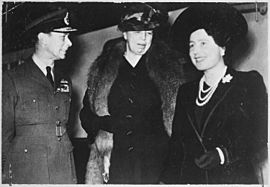
The King and Queen worked at Buckingham Palace. But they stayed at night at Windsor Castle for safety. The Palace lost many staff to the army. Most rooms were closed. Windows were broken by bombs and boarded up. During the "Phoney War", the Queen was trained to use a revolver. This was due to fears of an invasion.
Adolf Hitler reportedly called her "the most dangerous woman in Europe." He saw her popularity as a threat. Before the war, she and her husband supported appeasement. They believed war should be avoided at all costs. After Prime Minister Chamberlain resigned, Winston Churchill formed a government. The King and Queen came to admire Churchill. At the end of the war in 1945, Churchill was invited to the palace balcony.
Post-War Years
In the 1945 British election, Churchill's party lost. The Labour party of Clement Attlee won. Elizabeth's political views were private. But she once wrote that Attlee's "socialist heaven" was fading. She seemed to love the "dear old Labour Party" later on.
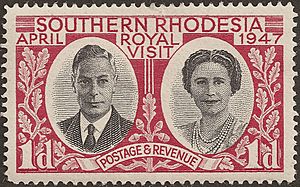
During a 1947 tour of South Africa, Elizabeth did something unusual. She struck an admirer with her umbrella. She thought his excitement was hostility. A planned 1948 tour of Australia and New Zealand was postponed. This was because of the King's poor health. In 1949, he had surgery on his leg. In 1951, Elizabeth and her daughters took over his public duties. In September, he was diagnosed with lung cancer.
After surgery, he seemed to get better. But the trip to Australia and New Zealand was changed. Princess Elizabeth and her husband went instead. The King died in February 1952. Princess Elizabeth and her husband were in Kenya. They returned to London right away.
Queen Mother (1952–2002)
Life as a Widow
King George VI died in his sleep on February 6, 1952. Elizabeth was then called Her Majesty Queen Elizabeth The Queen Mother. This was to avoid confusion with her daughter, Queen Elizabeth II. People often called her the "Queen Mother" or "Queen Mum."
She was very sad after the King's death. She went to Scotland to grieve. But after meeting with Prime Minister Winston Churchill, she returned to her duties. She became just as busy as Queen Mother as she had been as Queen. In July 1953, she made her first overseas visit. She went to Rhodesia and Nyasaland with Princess Margaret. She laid the foundation stone for the University College of Rhodesia and Nyasaland.
She oversaw the repair of Castle of Mey. This remote castle in Scotland was her escape. She used it to "get away from everything." She loved horse racing, especially steeplechasing. She owned horses that won about 500 races. Her racing colors were blue with buff stripes. Her horse, Devon Loch, famously stopped just before the finish line in 1956. She never placed bets, but she had race commentaries sent to her home. As an art collector, she bought works by famous artists.
In February 1964, she had emergency surgery for appendicitis. This delayed a planned tour. She recovered during a Caribbean cruise. In December 1966, she had surgery for colon cancer. In 1982, she was rushed to the hospital. A fish bone got stuck in her throat. She joked, "The salmon have got their own back." She had other health issues later in life. These included a broken hip and another cancer operation.
In 1975, she visited Iran. The British ambassador noted how she spoke to everyone. She did not care about their status. Between 1976 and 1984, she made yearly summer visits to France. Queen Elizabeth was known for her charm. She was one of the most popular members of the royal family. Her unique style included large upturned hats.
A Centenarian Queen
In her later years, the Queen Mother was known for living a long time. Her 90th birthday in 1990 was celebrated with a parade. Many of the 300 organizations she supported took part. In 1995, she attended events marking the end of the war. She also had two operations that year. One was for a cataract, and the other for a hip replacement. In 1998, her left hip was replaced after a fall.
Her 100th birthday was celebrated in many ways. A parade showed highlights of her life. Her image appeared on a special £20 note. She attended a lunch where the Archbishop of Canterbury accidentally tried to drink her wine. She quickly said, "That's mine!" which made everyone laugh. In November 2000, she broke her collarbone in a fall. On August 1, 2001, she had a blood transfusion. This was for anemia after heat exhaustion. But she was well enough to appear for her 101st birthday. Her last public events were in November 2001.
In December 2001, at 101, she fractured her pelvis in a fall. Still, she stood for the National Anthem. This was at her husband's memorial service in February 2002. Just three days later, her second daughter, Princess Margaret, died. On February 13, 2002, the Queen Mother fell and cut her arm. She was determined to attend Margaret's funeral. She flew by helicopter to Windsor. She used a car with blacked-out windows. This was so no photos of her in a wheelchair could be taken. Her health got worse in her last weeks.
Death and Legacy
On March 30, 2002, at 3:15 PM (GMT), the Queen Mother died in her sleep. She was at Royal Lodge, Windsor Great Park. Her daughter, Queen Elizabeth II, was by her side. She had been suffering from a cold for four months. She was 101 years old. At the time, she was the longest-lived member of the British royal family. This record was later broken by her sister-in-law, Princess Alice.
Elizabeth loved camellia flowers. Before her coffin was taken to Westminster Hall, camellias from her gardens were placed on it. More than 200,000 people visited her as she lay in state. Guards from the armed forces stood watch. At one point, her four grandsons stood guard. This was a special honor called the Vigil of the Princes. It had only happened once before.
On the day of her funeral, April 9, Canada asked its people to honor her. In Australia, the Governor-General read a lesson at a memorial service. In London, over a million people filled the areas around Westminster Abbey. They also lined the route to her burial place. She was buried next to her husband and younger daughter. This was at St George's Chapel, Windsor Castle. At her request, the wreath from her coffin was placed on the Tomb of the Unknown Warrior. This honored her wedding day tribute 79 years earlier.
Remembering Queen Elizabeth
Sir Hugh Casson said Elizabeth was like "a wave breaking on a rock." He meant she was sweet and charming. But she also had a strong, tough side. This came from her principles, courage, and sense of duty. Peter Ustinov described her during a student protest in 1968. Students threw toilet rolls at them. The Queen Mother calmly picked them up. She asked, "Was this yours? Oh, could you take it?" Her calm reaction silenced the students. She knew exactly what to do.
Elizabeth was known for her witty remarks. When she heard someone was buried at sea, she said, "Dear Edwina, she always liked to make a splash." She was once with the writer Sir Noël Coward. She saw him looking at soldiers. She whispered, "I wouldn't if I were you, Noël; they count them before they put them out." She also joked about her love for alcohol. Some journalists found her expensive lifestyle amusing. This was especially true when her large bank overdraft was revealed.
Her habits were often made fun of in a kind way. The 1980s TV show Spitting Image showed her with a Birmingham accent. She always had a copy of the Racing Post. She has been played by many actresses in films and TV shows. These include Helena Bonham Carter in The King's Speech and Olivia Colman in Hyde Park on Hudson.
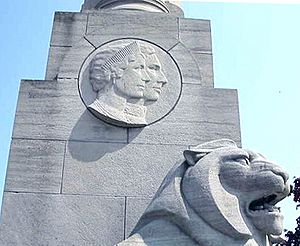
The Cunard White Star Line's ship, RMS Queen Elizabeth, was named after her. She launched the ship in 1938. The ship started to slide too early. But she quickly smashed a bottle of wine over its bow. In 1954, Queen Elizabeth sailed to New York on her namesake ship.
A statue of Queen Elizabeth The Queen Mother was unveiled in London in 2009. It stands near the statue of her husband, King George VI. This created the King George VI and Queen Elizabeth Memorial.
In 2011, her musical tastes were shared. Her record collection included ska, folk music, and musicals. She also liked artists like Montana Slim and The Goons.
Eight years before her death, she put most of her money into trusts. This was for her great-grandchildren. She left most of her estate to her daughter, Queen Elizabeth II. This included paintings, Fabergé eggs, jewelry, and horses. Property passing from monarch to monarch is not taxed. So, a large tax bill was avoided. The most important art pieces went to the Royal Collection.
Titles, Styles, and Family
Titles and Styles
- August 4, 1900 – February 16, 1904: The Honourable Elizabeth Bowes-Lyon
- February 16, 1904 – April 26, 1923: Lady Elizabeth Bowes-Lyon
- April 26, 1923 – December 11, 1936: Her Royal Highness The Duchess of York
- December 11, 1936 – February 6, 1952: Her Majesty The Queen
- February 6, 1952 – March 30, 2002: Her Majesty Queen Elizabeth The Queen Mother
Her Children
| Name | Birth | Death | Marriage | Their children | Their grandchildren | |
|---|---|---|---|---|---|---|
| Date | Spouse | |||||
| Queen Elizabeth II | April 21, 1926 | November 20, 1947 | Prince Philip of Greece and Denmark | Prince Charles, Prince of Wales | Prince William, Duke of Cambridge Prince Harry, Duke of Sussex |
|
| Princess Anne, Princess Royal | Peter Phillips Zara Tindall |
|||||
| Prince Andrew, Duke of York | Princess Beatrice of York Princess Eugenie of York |
|||||
| Prince Edward, Earl of Wessex | Lady Louise Windsor James, Viscount Severn |
|||||
| Princess Margaret, Countess of Snowdon | August 21, 1930 | February 9, 2002 | May 6, 1960 Divorced July 11, 1978 |
Antony Armstrong-Jones | David Armstrong-Jones, 2nd Earl of Snowdon | Charles Armstrong-Jones Margarita Armstrong-Jones |
| Lady Sarah Chatto | Samuel Chatto Arthur Chatto |
|||||
Images for kids
-
The Duchess of York in Queensland, 1927
-
Eleanor Roosevelt (centre), King George VI and Queen Elizabeth in London, October 23, 1942
-
The Queen and Princess Elizabeth talk to paratroopers preparing for D-Day, May 19, 1944
-
The Queen Mother as guest of honor at the Columbia University Bicentennial in New York City, October 1954
-
At Banting House during a royal visit to Canada, 1989
See also
 In Spanish: Isabel Bowes-Lyon para niños
In Spanish: Isabel Bowes-Lyon para niños


